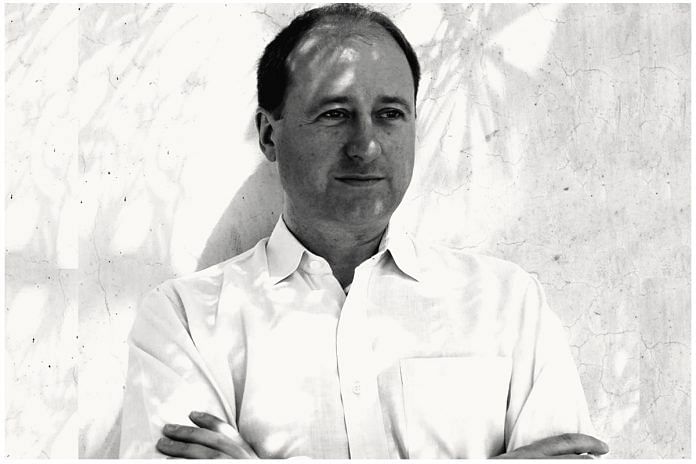New Delhi: “The greatest thing about being a writer is that you have freedom to say what you think,” Patrick French had said in 2003 while declining an Order of the British Empire (OBE).
And Patrick French said, and wrote, exactly what he thought.
The noted British writer and biographer died of cancer in London Thursday, after an illustrious career chronicling India and her inconsistencies. He was 56.
His award-winning work includes a biography of writer V.S. Naipaul, titled ‘The World Is What It Is: The Authorised Biography of V.S. Naipaul’, a book on Partition called ‘Liberty After Death’, and ‘Tibet, Tibet: A Personal History of a Lost Land’.
His most recent book ‘India: A Portrait’, was published in 2011 and tracks the socioeconomic changes that were taking place across the country at the time.
French has also written a lot about India and her politics, contributing often to newspapers and publications across the country. He was the inaugural dean of the School of Arts and Sciences at Ahmedabad University in 2017, and even took classes at institutions like Ashoka University.
He is survived by his wife Meru Gokhale, former editor-in-chief at Penguin Random House India, and four children.
Tweets of support from friends and colleagues like William Dalrymple and Ramachandra Guha have been pouring in online, describing him as warm, witty, and wonderful.
Deeply saddened to hear of the passing of Patrick French. He was a wonderful writer, whose books on Francis Younghusband and VS Naipaul are classics of modern biographical writing. He was also a very fine human being, unfailingly generous to friends and strangers alike.
— Ramachandra Guha (@Ram_Guha) March 16, 2023
Heartbroken to hear about the death of Patrick French, who I have loved and admired since we were both thirteen, and who was the Best Man at my wedding. He was funny & clever & charming, always full of enthusiasm & energy. He was also the greatest biographer of our generation.
— William Dalrymple (@DalrympleWill) March 16, 2023
Also Read: V.S. Naipaul was like family. Even if you didn’t love him, he was part of your story
Biographer of India at large
In a genre known for pedestalising people, French’s astonishingly refreshing portrayals of his subjects didn’t shy away from exploring their darker underpinnings.
His first biography retraced the steps of famous British explorer Francis Younghusband, which went on to win the Somerset Maugham Award among others. His biography of Naipaul won the National Book Critics Circle Award and was shortlisted for others, besides being selected by the New York Times Book Review as one of the best books of 2008.
But one of his best known works is more personal to India — ‘India: A Portrait’ is an intimate biography of one billion Indians.
The breadth of the work is expansive — having travelled across the country, French weaves together the narratives of all kinds of Indian lives to tell a larger story about a country with unlimited potential. He does this by offering random snapshots from across India, anecdotes from his reporting complete with charts and graphs to back his observations. The people he profiles in the book range from those of tea-sellers to the parents of Arushi Talwar, murdered in 2008.
The book was no stranger to controversy. Pankaj Mishra reviewed it twice, referring to it as having an imperial lens. French branded Mishra’s review a “cheap shot” — “For a reviewer, it is the cheapest shot in the locker to compare any foreigner you disagree with to a British imperialist. For the record, I am the first member of my family to go to the subcontinent.”
French never tried to sum up a neatly tied argument about India. “The nation can be triangulated in many ways: it is all India,” he writes in ‘India: A Portrait’, trying to make sense of a complex and often contradictory culture.
From history to politics
French’s 1997 book on the events leading up to the Partition of India wore that rare badge of honour — there was an attempt to ban it when it was first published.
The book, ‘Liberty or Death’, ended up doing extremely well in India — Khushwant Singh described French as a “first rate historian and storyteller” based on it.
From then on, French lived in India and closely followed Indian politics. In 1998, he profiled Sonia Gandhi for The New Yorker after watching her speak at Medak, Telangana, describing the Congress as a family heirloom that she is trying to preserve.
Nearly twenty years later, in 2016, he spent an evening with Amit Shah, who he profiled for Hindustan Times. “Shah likes to answer a question with a question,” he observed. “While we are speaking, he leans back in his white kurta pajama and taupe waistcoat, rubs his cranium and receives nuggets of information by phone. Whatever else he may be, he is a formidable political opponent.”
Also Read: How political elites are placed in India today, and their impact on state capacity



